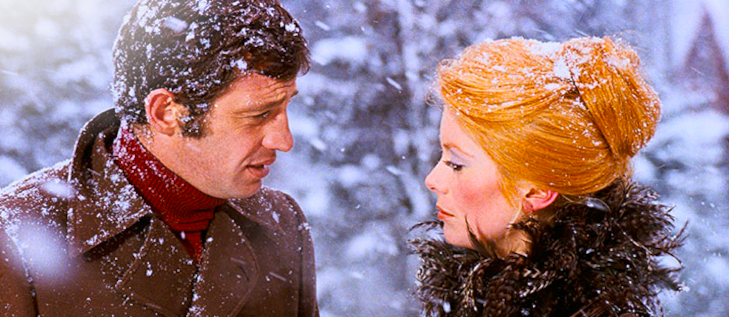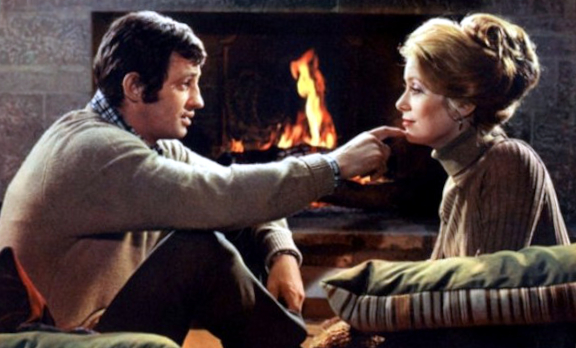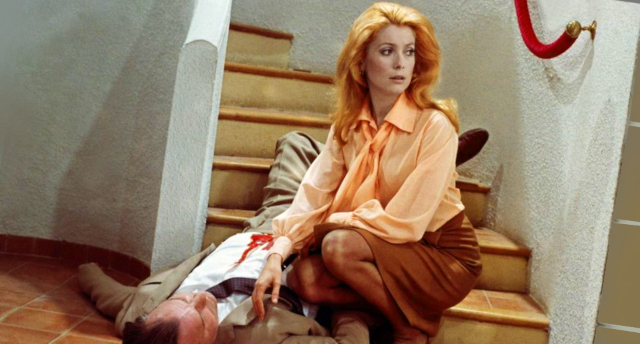Mississippi Mermaid
François Truffaut is back with another Hitchcock-influenced adaptation of a Cornell Woolrich murder thriller, with stars Catherine Deneuve and Jean-Paul Belmondo as lovers – criminals – fugitives, and partly filmed in a remote French island in the Indian Ocean. It’s a tale of a mail-order bride, larcenous deception, and irrational amor fou run amuck. The things we do for love sometimes obey no logic. Also starring Michel Bouquet.

Mississippi Mermaid
Blu-ray
KL Studio Classics
1969 / Color / 2:35 widescreen / 123 110 min. / La Sirène du Mississippi / Street Date February 14, 2023 / available through Kino Lorber / 24.95
Starring: Jean-Paul Belmondo, Catherine Deneuve, Michel Bouquet, Nelly Borgeaud.
Cinematography: Denys Clerval
Production Designer: Claude Pignot
Deneuve dresses: Yves Saint-Laurent
Film Editor: Agnès Guillemot
Original Music: Antoine Duhamel
Screenplay by François Truffaut based upon the novel Waltz into Darkness by William Irish (Cornell Woolrich)
Produced by Marcel Berbert
Directed by François Truffaut
 François Truffaut was the least radical of the official New Wave directors. He brought a looser, less formal technique to increasingly conventional dramas. His relaxed manner with actors made his early films seem improvised, as if his camera had just managed to capture the events we see. Jules & Jim is like a poet’s sketchbook, a hit & miss affair connecting brilliant bits of spontaneity to long sequences anchored with traditional voiceovers. Truffaut altered tone for his Hitchcock kick in the middle ’60s. Of his two ‘Hitchcockian’ Cornell Woolrich adaptations, The Bride Wore Black is a successful, if formally dry, storyboard construction. His 1969 Mississippi Mermaid tries to have it both ways. The story is a rigid noir of betrayal and amour fou; Truffaut’s execution leans back toward the ‘let’s just observe the behaviors’ quality that serves him well.
François Truffaut was the least radical of the official New Wave directors. He brought a looser, less formal technique to increasingly conventional dramas. His relaxed manner with actors made his early films seem improvised, as if his camera had just managed to capture the events we see. Jules & Jim is like a poet’s sketchbook, a hit & miss affair connecting brilliant bits of spontaneity to long sequences anchored with traditional voiceovers. Truffaut altered tone for his Hitchcock kick in the middle ’60s. Of his two ‘Hitchcockian’ Cornell Woolrich adaptations, The Bride Wore Black is a successful, if formally dry, storyboard construction. His 1969 Mississippi Mermaid tries to have it both ways. The story is a rigid noir of betrayal and amour fou; Truffaut’s execution leans back toward the ‘let’s just observe the behaviors’ quality that serves him well.
The film was fully restored for American viewers in the middle 1990s. * When United Artists imported the picture they slashed it by a full 13 minutes, and scrambled the meaning of its title as well. ‘Mississippi’ is the name of a boat, not a woman. The original La Sirène du Mississippi conjures up the appropriate image of a Siren, a femme fatale. ‘Mississippi Mermaid’ sounds like something set down in the mud marshes, with Burt Reynolds and Daryl Hannah.
Filmed in color and anamorphic Dyaliscope, Truffaut’s adaptation begins with the fated meeting of French colonial tobacco planter Louis Mahé (Jean-Paul Belmondo) and Julie Roussel (Catherine Deneuve), a mail order bride who traveled 7,000 miles to join him in a distant corner of the Indian Ocean. Upon arrival, Julie looks nothing like her photo — actually better than her photo. Both wrote letters that hid facts as a test of sincerity, she her beauty and he his wealth. A genuine romance blooms.
All is glorious until Julie abruptly disappears, taking with her the bulk of Louis’ fortune. Not only that, Berthe Roussel (Nelly Borgeaud) arrives looking for her missing sister Julie: Louis’ ‘Julie’ seems to be an imposter. Infuriated, Louis hires the dogged detective Comolli (Michel Bouquet of The Bride Wore Black and The Day of the Jackal) to track down the mystery woman. Louis also returns to France and by the wildest chance finds Julie working as a club hostess. Her real name is Marion Vergano. She claims that she was the pawn of someone named Robert, who pushed Julie Roussel overboard on the sea voyage. Although Louis doesn’t really believe Marion, he finds himself unable to act against her. Beyond all logic and wisdom, he abandons his life to join her on the run from the authorities. Not soon thereafter, he becomes a murderer as well. The only question is, is the cool customer Marion capable of reciprocating Louis’ unconditional love?
Much of Mississippi Mermaid was filmed in the Indian Ocean on the island of Réunion. Truffaut begins with a map and a geography lesson. The prologue includes with a sequence from Jean Renoir’s La Marseillaise (1938), to illustrate the origin of the island’s name; the movie is dedicated to Renoir as well. As part of their ‘palace coup’ to become directors, the New Wave critics of Cahiers du Cinéma trashed an entire generation of French filmmakers’ work as artistically invalid. They favored contemporary American directors, leaving a French void that they could fill in person. As Renoir is beyond reproach, reaching back to honor him was consistent with their credo.
Truffaut approach to Woolrich’s very Hitchcockian story is less formalized than for his previous thriller. The wide screen avoids restrictive compositions, giving us airy vistas of Mahés plantation and street-level views of various French towns and cities as the fugitives make their way to Switzerland. There are Hitchcock allusions aplenty. Louis breaks down from emotional exhaustion upon returning to France, and is briefly hospitalized, as with Gregory Peck in Spellbound. The murder backstory is suggestive of Hitchcock’s Vertigo: a man is made a patsy by a woman who has assumed a false identity, and who is herself the puppet of a murderer planning to fool them both. In both cases, ‘victim’ and femme fatale fall mutually in love. As my mentor James Ursini would say, that’s amour fou in a nutshell.
Truffaut also quotes cult director Joseph H. Lewis. At one point Louis and Marion are in their car when they discover that their hotel is surrounded by police, and realize that they will have to abandon the small fortune they’ve hidden in their room. The entire scene is filmed from the back seat of their car in one unbroken camera take, just like the one-take bank robbery in Lewis’s Gun Crazy. As if playing a personal game with Jean-Luc Godard, Truffaut also devotes half a scene to a discussion of Nicholas Ray’s Johnny Guitar. In 1969, many American audience members may have thought that Johnny Guitar was a made-up title.
Beyond those in-references Truffaut also riffs on the screen personae of his leading players. Although the established action-man Belmondo climbs one wall and jumps a fence or two, his Louis doesn’t resolve problems with his fists. He’s repeatedly blind-sided by a devious female and fate itself. He throws away his family fortune, his land and his factory, all over his obsession with this woman. Louis Mahé may be the biggest loser in all of Loser Noir, yet he never despairs of what he’s lost.
Catherine Deneuve doesn’t drop her image as a slightly icy beauty, but she no longer seems a delicate flower. When confronted with her villainy she claims indifference — she doesn’t care, and if Louis can’t accept that he should just kill her. In a way, Deneuve’s Marion Vergano is an extension of the Hitchcockian blonde, a woman who can be anything as the need arises — virtuous, available, a slut. Deneuve even has a couple of brief nude scenes, as if further distance herself from her character in Demy’s The Umbrellas of Cherbourg. Louis and Marion don’t conform to genre norms, and we’re curious to see where Truffaut will take them.
He doesn’t take them very far, as it turns out. Mississippi Mermaid resolves its character conflicts with verbal speeches. Louis delivers a very Uncle Charlie- like condemnation of the women that attract him:
“You think that you’re a real person, that you’re unique. But you’re not. You’re just one in a growing multitude of girls now… not really bitches, not really adventuresses or whores, no… But some kind of parasite… who live outside normal society. You’re not women or girls. You’re chicks.”
The ‘crazy’ romance boils down to a passive choice between happiness and death. When Marion is moved by Louis’ apparent willingness to be murdered, she offers a speech about shared love and commitment. As we’re expecting more duplicity from Marion, we’re surprised by her sincerity. Faced with a conventional storytelling problem, New Waver Truffaut falls back on visual cliché that an ‘invalid’ older French director might use. When Louis receives a letter, Truffaut holds it in close-up, superimposing the face of its sender while it’s read aloud . . . just as in a soapy Lana Turner melodrama.
On the other hand, we like the little scene showing new labels being printed for Louis’s cigarette packets, sporting Julie’s likeness. As with the printing press in Bride Wore Black that churns out wanted posters with images of Jeanne Moreau, the multiplied images suggest the nature of obsession. Truffaut’s style and approach avoids the efficient ‘everything connects’ kind of plotting we expect in thrillers. A more conventional tight story structure would make the cigarette pack an important object in a later scene, helping the detective Comolli to identify Marion, perhaps.
Mississippi Mermaid shows Truffaut’s strengths and weaknesses in equal measure. At least it’s not him trying on another director’s style. Both of his Cornell Woolrich thrillers intrigue and entertain. The earlier show probably has an advantage, with its more satisfying conclusion — Mermaid remains a little loose.
The KL Studio Classics Blu-ray of Mississippi Mermaid looks and sounds very good. It is likely the same video master as used on the 2015 Twilight Time disc — the opening title card is dirty and the same (very minor) flaws persist throughout. Colors are excellent but the film has a slightly soft look overall.
* It’s important to assure viewers that the Mississippi on this new disc hasn’t reverted to an older, shorter cut. If you saw the movie in a U.S. theater before 1996 or so, it was likely United Artists’ old cut-down version, slashed by a full 13 minutes. MGM’s John Kirk reinstated six entire scenes from original French film elements, translating new English subtitles for them as well. It’s no wonder that the movie did not fare well on its first U.S. release — those 13 missing minutes contain a great deal of character detail.
On a large monitor the picture’s impact is quite strong. At one point we see a slow fade-up apparently done in the camera, as the image is clean. The final shot is a slow fade to white, and is likely an optical because it isn’t so pristine. This parting image of the picture will, I bet, influence the overall judgment on the quality of the transfer. Yes, I’d like to see all that cleaned up as well. François Truffaut probably felt the same way watching his answer print in 1969.
We also appreciate Antoine Duhamel’s music more. It doesn’t take over the viewing experience, like the operatic Bernard Herrmann music for The Bride Wore Black, but it does help set up the emotional developments at film’s end. One reason to retain the OOP Twilight Time disc is its isolated music score track, which is not present here. Kino has ported over the excellent audio commentary by Julie Kirgo with the late Nick Redman. They appear to be committed Truffaut fans.
Kino’s slip case artwork is reversible, with a choice of poster designs. The original trailer doesn’t do much to raise interest in the film. United Artists released dozens of worthy European art pictures in the 1960s and ’70s — but reportedly lost money on almost all of them in America.
. . . by the way, we’ve found another full-length YouTube encoding of Jean-Paul Belmondo’s incredibly regal state funeral, surely one of the most moving, classiest ever … the slow march music is Ennio Morricone’s Chi Mai. Avoid online clips with commentator blab superimposed.
Reviewed by Glenn Erickson

Mississippi Mermaid
Blu-ray rates:
Movie: Very Good
Video: Excellent
Sound: Excellent
Supplements:
Audio Commentary by Julie Kirgo and Nick Redman
Theatrical Trailer.
Deaf and Hearing-impaired Friendly? YES; Subtitles: English (feature only)
Packaging: One Blu-ray in Keep case
Reviewed: March 7, 2023
(6894miss) 
Visit CineSavant’s Main Column Page
Glenn Erickson answers most reader mail: cinesavant@gmail.com
Text © Copyright 2023 Glenn Erickson









